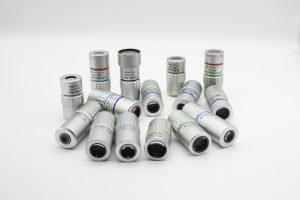Design for Manufacturing (DFM) Case Study: Objective Lens Design for Trapping and Imaging Single Atoms
At Avantier we offer Design for Manufacturing (DFM services), optimizing product design with our extensive knowledge of manufacturing constraints, costs, and methods. Avantier Inc. received a request from a University Physics department to custom design a long working distance, high numerical aperture objective. Our highly skilled and knowledgeable engineers designed and deployed state-of-the-art technologies to develop a single-atom trapping and imaging system where multiple laser beams are collimated at various angles and overlapped on the dichroic mirrors before entering the objective lens. The objective lens focuses the input laser beams to create optical tweezers arrays to simultaneously trap single atoms and image the trapped atoms over the full field of view of the microscope objective. The objective lens not only had high transmission but also can render the same point-spread function or diffractive-limited performance for all traps over the full field of view.
Typical requirements for the objective lens used for trapping and imaging single atoms:
- Having high damage threshold with low scattering and absorption rate for handling high-power lasers at different wavelengths
- Delivering diffraction limited performance for all input laser beams and imaging wavelength at the fixed focal plane over the entire field of view
- High transmission, especially at imaging wavelength
- Minimizing chromatic shifts/aberrations at all laser wavelengths
Custom objective lens example
Objective lens focuses high-power laser beams to create optical tweezers at 6 wavelengths (i.e., 420nm, 795nm, 813nm, 840nm, 1013nm, and 1064nm) and image the trapped atoms at the wavelength of 780nm.
- The objective lens is designed to produce diffraction limited performance at the fixed focal plane for the 6 laser wavelengths and 1 imaging wavelength. The figures below show the MTF plots at 813.4nm, 780nm, 420nm and 1013nm.
- The objective lens is designed to have a total focal shift of less than 2 µm for the 6 designed laser wavelengths and 1 imaging wavelength. The chromatic focal shift is shown in the following figure.
- The figure above is a photo of the manufactured objective lens. We used the active alignment method to eliminate the effect of optical fabrication errors on the optical performance of the lens.
- We tested our manufactured objectives by capturing the images of a test target with pin holes/stars of size 1 µm ~ 3 µm over the entire field of view in the optical workshop. The transmission and point spread function were measured in a research lab. According to our customer’s test results, our objective transmission is above 85% across the bandwidth and delivers diffractive-limited PSF at 780nm when imaging the trapped atoms.
GREAT ARTICLE!
Share this article to gain insights from your connections!







